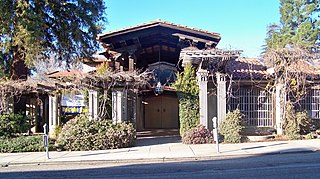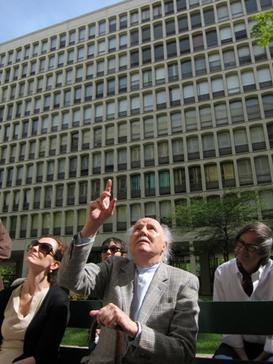
Bernard Ralph Maybeck was an American architect in the Arts and Crafts Movement of the early 20th century. He was an instructor at University of California, Berkeley. Most of his major buildings were in the San Francisco Bay Area.

The First Church of Christ, Scientist is the administrative headquarters and mother church of the Church of Christ, Scientist, also known as the Christian Science church. Christian Science was founded in the 19th century in Lynn, Massachusetts, by Mary Baker Eddy with the publication of her book Science and Health (1875).

Solon Spencer Beman was an American architect based in Chicago, Illinois and best known as the architect of the planned Pullman community and adjacent Pullman Company factory complex, as well as Chicago's renowned Fine Arts Building. Several of his other largest commissions, including the Pullman Office Building, Pabst Building, and Grand Central Station in Chicago, have since been demolished. Beman designed numerous Christian Science churches and influenced the design of countless more.

The Christian Science Center is a 13.5-acre (5.5 ha) site on the corner of Massachusetts Avenue and Huntington Avenue in the Fenway neighborhood of Boston, Massachusetts. A popular tourist attraction, the center is owned by the Church of Christ, Scientist, which refers to it as Christian Science Plaza. The complex, including most of the landscape was designated as a Boston Landmark by the Boston Landmarks Commission in 2011.
The First Church of Christ, Scientist, in Boston, Massachusetts, U.S., is the administrative headquarters and mother church of the Church of Christ, Scientist.

First Church of Christ, Scientist, Berkeley, now also known as Christian Science Society, Berkeley, is a Christian Science church, located at 2619 Dwight Way at Bowditch Street across the street from People's Park, in Berkeley, in Alameda County, California.

The former Second Church of Christ, Scientist, located at 655 Cedar Avenue, in Long Beach, California, is an historic structure that on April 1, 2005, was added to the National Register of Historic Places. It is now the Second Samoan Church.

Second Church of Christ, Scientist is a historic former Christian Science church building located at 948 West Adams Boulevard, in the West Adams district of Los Angeles, California. It is now the Art of Living Center Los Angeles.

The former First Church of Christ, Scientist is an historic Christian Science church building located at 1200 North Robinson Avenue in Oklahoma City, Oklahoma, United States. Built in 1920, it was designed in the Classical Revival style of architecture. On September 9, 2001, was added to the National Register of Historic Places.
The former First Church of Christ, Scientist, built in 1922, is an historic Classical Revival style Christian Science church located at 15422 Detroit Avenue, on the northeast corner of Detroit and Arthur avenues, across from the Public Library in Lakewood, Ohio. Its massive entrance portico is supported by six Doric columns. It was designed by noted Chicago-based architect Charles Draper Faulkner, who was renowned for the churches and other buildings that he designed in the United States and Japan. He designed over 33 Christian Science church buildings and wrote a book called Christian Science Church Edifices which features this church as well as many others.

The former First Church of Christ, Scientist, built in 1912, is a historic Christian Science church edifice located at 1366 South Alvarado Street in Pico-Union, Los Angeles, California.

First Church of Christ, Scientist, built in 1901, is an historic Mission Revival-style Christian Science church located at 3606 Lemon Street in Riverside, California. It has been called: "the church that introduced Christian Science to Southern California." It was designed by noted Los Angeles architect Arthur Burnett Benton. On September 22, 1992, First Church of Christ, Scientist, was added to the National Register of Historic Places. It is still listed in the Christian Science Journal as an active Christian Science church.

Third Church of Christ, Scientist, established in 1918, is a Christian Science church in downtown Washington, D.C. From 1971 to 2014, the church was located in a controversial building at 16th and I Street NW. Considered a significant work of "Brutalist" church architecture by some critics, the building was considered unsatisfactory by members of the Church's congregation, which shrank over the years. In 2007, the church applied for a demolition permit for the building to permit sale and redevelopment of the site, with plans to relocate to a more suitable structure. A 1991 application for landmark status for the building, filed to forestall a demolition threat then, was subsequently approved. After a lawsuit and hearings, the District of Columbia issued a demolition permit in May 2009, and the building was demolished in 2014. In 2015, Third Church merged with First Church of Christ, Scientist. The congregation continues as First Church and conducts its activities in a portion of the new building.

Fifth Church of Christ, Scientist is an historic Classical Revival-style Christian Science church building located at 9 East 43rd Street near Madison Avenue and Grand Central Terminal in Manhattan, New York City. Built in 1921 on the former site of St. Bartholomew's Episcopal Church. Fifth Church of Christ, Scientist, is unusual in that it occupies part of the first two stories of a 21-story office building that was originally named the Canadian Pacific Building. The church auditorium seats 1800 people.

The former First Church of Christ, Scientist, is an historic Christian Science church building located at 700 22nd Street, Rock Island, Illinois, United States. Designed by architect William C. Jones of Chicago in the Palladian style, it was built between 1914-1915. Its exterior walls are of brick covered by Bedford limestone. Its superimposed front portico is supported by six 2 story columns with egg-and-dart capitals. Its dome actually consists of 2 domes: an outer dome and an inner dome which are separated by a space for lighting fixtures and maintenance. The inner dome consists of some 8,000 colored fish scale glass panes on a wooden support structure. The inner dome is similar to the inner dome of First Church of Christ, Scientist in Kalamazoo, Michigan, which was designed by William C. Jones in 1913.

The former First Church of Christ, Scientist is an historic Christian Science church building located at 635 Clyde Street, in the Shadyside section of Pittsburgh, Pennsylvania United States. Built in 1904, it was designed in the Classical Revival-style of architecture by noted Chicago architect Solon Spencer Beman.

First Church of Christ, Scientist Building is an historic former Christian Science church located at 1519 East Denny Way / 1841 16th Avenue on the corner of East Denny Way and 16th Avenue in the Capitol Hill neighborhood of Seattle, Washington. Designed in the Classical Revival style, it was built of Bedford limestone between 1906 and 1909. Established in August 1896, First Church first held services in various rented buildings or halls until building its first church building on the corner of 6th Avenue and Marion Street. This was completed in time for its first service on Easter Sunday, April 7, 1901. This was soon outgrown and in November 1906 a contract was signed to purchase the Denny Way property. In August 1908, services began in a temporary wooden structure that was built on the completed foundation of the new church. On January 17, 1977, the building was declared a City of Seattle historic landmark. In 2006 the congregation made the decision to move to the South Lake Union neighborhood to be in a more active urban location. The building on East Denny Way was sold to a developer who has since converted it into townhouse project called The Sanctuary. First Church of Christ, Scientist, Seattle, now holds services at 900 Thomas Street and is still an active branch of the Christian Science Mother Church.

The former Sixth Church of Christ, Scientist, built in 1902, is an historic Christian Science church edifice located at 1036 North Van Buren Street in Milwaukee, Wisconsin. In 1980 the building was added to the National Register of Historic Places. On May 17, 1983, Sixth Church was made a locally designated historic site by the city of Milwaukee.

Araldo Cossutta was an architect who worked primarily in the United States. He worked at the firm I. M. Pei & Partners from 1956 to 1973. I. M. Pei has been among the most honored architects in the world. Cossutta was Pei's associate and ultimately his partner in the first phase of Pei's career. He was responsible for some of the firm's best-known designs from that era, including three that have received "landmark" designations in recent years. In 1973 he and Vincent Ponte left Pei's firm to form Cossutta & Ponte, which ultimately became Cossutta and Associates. The new firm designed the Credit Lyonnais Tower in Lyon, France (1977) and the Tower at Cityplace (1988) in Dallas, Texas, among other commissions.


















